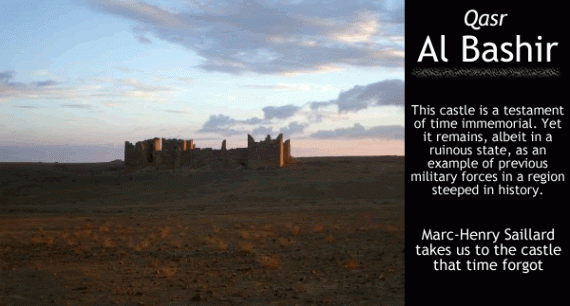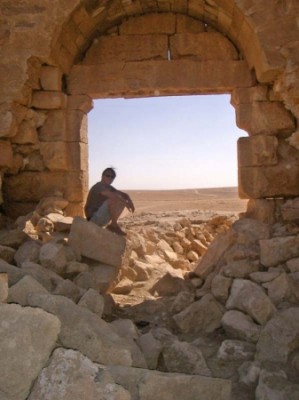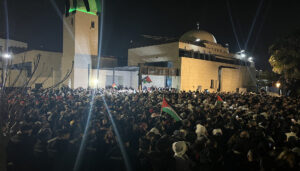The Castle That Time Forgot: Qasr Al Bashir
Written by Marc-Henry Saillard
The beautiful Middle Eastern sun begins to set just as it has for many times before on this remote site. What makes this site that much more incredible than watching the sun set from anywhere else is the history you are sitting on.
This castle is a testament to time immemorial; surviving military attacks, earthquakes and the fall of one of history’s greatest empires, the Roman Empire. Yet it remains, albeit in a ruinous state, as an example of previous military forces in a region steeped in history.
I’ve discovered an old Roman Castle, from the late Roman Empire in the Jordanian desert. It is located roughly 100 kilometers south of Amman in between the Dead Sea Highway and the Desert Highway. The castle is in the middle of nowhere and it seems that hardly anyone knows that it still exists.
The best part is, besides discovering a site that has been seemingly forgotten by the rest of the world is that when you are there, you feel that you are on the far side of the world.
The castle is known as Qasr Al Bashir and was built between 293 AD and 305 AD by the Romans to defend the southern border of the Roman Empire against the Bedouin tribes’ attacks in this region. It was built along the Via Nova Trajana which was in those times the highway which linked Palmyra, Damascus, Jerash, Philadelphia, and Aila (Aqaba) – a total distance of roughly 430km from North to South.
Along this corridor that once linked the Roman empire, there were 23 auxiliary cavalry castles like Qasr Al Bashir, 14 watch towers and 2 caravanseray, which are inns with a central courtyard used in the desert regions of Asia and North Africa.
After being conquered in 114 by Emperor Trajan, the region known as Arabia Petraea or Provincia Arabia, (present day Jordan, South Syria and Northern parts of Saudi Arabia) the Roman army built this infrastructure to defend its newly acquired lands. Marcus Ulpius Nerva Traianus, most commonly known as Trajan was Roman Emperor in 98–117. During his rule, the Roman Empire grew to its largest territorial area.
At the same time, Rome conquered Jordan’s beloved Petra and established a new capital in Bosra (South Syria) and sent three legions to enforce Roman law and defend the land (the most well know legion was 3rd Cyrenaica). This defence system is called the Limes Arabicus, a border defense system that Ancient Rome used to defend and mark the boundaries of its empire.
All the castles similar to Qasr Al Bashir were guarded by auxiliary cavalry, which were commanded by Roman officers, but the main contingent of soldiers were local inhabitants. The principal duty was to monitor Bedouins and prevent attacks in the Arabia Petraea.
Those castles along the Via Nova Trajana were connected to each other by this highway and used smoke and fire to communicate with each other. To increase the security and the communication, the castles were established 15 km from each other to be seen easily. Being this close, reinforcements could come quickly and easily defend the province.
Nowadays, Qasr Al Bashir is one of a number of interesting castles in the entire region. This castle was inaugurated in 305 AD by the prefect of the region under the name of “Castra Praetorii Mobeni” in the name of the Emperor Diocletian. We know that, because on the top of the main entrance of the fort there still is the inscription which describes to whom this castle is dedicated and its function. This kind of inscription is very rare and this castle is one of the last Roman structures in the Middle East which still has the inscriptions.
While being preserved, the fort is damaged by centuries of natural forces. The inner part is almost totally destroyed; we can still see the inner walls that separated the stables and the soldiers’ rooms. When the fort was running at full functionality, a complete cohort could live there. A cohort was introduced by Gaius Marius and consisted of 600 legionaries. After the reign of Augustus a cohort consisted of 450 and divided into six centuries of 80 men, each being commanded by a centurion.
The castle, due to military difficulties on the Northern border of the Roman Empire, was abandoned at the end of the 5th century. It was used by the Omayyad dynasty and then completely abandoned during the 8th century because of an earthquake in the region.
For me personally, this castle represents a very important testimony of the Roman presence in this region, and must be preserved and restored. Unfortunately, the archaeological department of the Ministry of Tourism and Antiquities has limited resources and prefers to invest in major sites such as Petra or Jerash.














